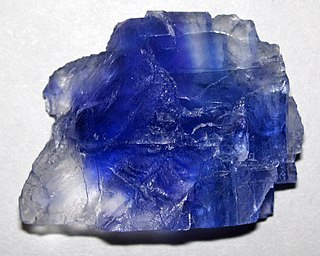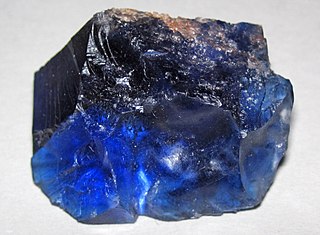
Chalk is a soft, white, porous, sedimentary carbonate rock. It is a form of limestone composed of the mineral calcite and originally formed deep under the sea by the compression of microscopic plankton that had settled to the sea floor. Chalk is common throughout Western Europe, where deposits underlie parts of France, and steep cliffs are often seen where they meet the sea in places such as the Dover cliffs on the Kent coast of the English Channel.
The Canning Basin is a geological basin located in Western Australia.
The mines of the West Coast of Tasmania have a rich historical heritage as well as an important mineralogical value in containing or having had found, specimens of rare and unusual minerals. Also, the various mining fields have important roles in the understanding of the mineralization of the Mount Read Volcanics, and the occurrence of economic minerals.
The Perth Basin is a thick, elongated sedimentary basin in Western Australia. It lies beneath the Swan Coastal Plain west of the Darling Scarp, representing the western limit of the much older Yilgarn Craton, and extends further west offshore. Cities and towns including Perth, Busselton, Bunbury, Mandurah and Geraldton are built over the Perth Basin.
The Mount Read Volcanics is a Cambrian volcanic belt that exists in Western Tasmania.
Duncan R. Derry (1906–1987) was an internationally known Canadian economic geologist. He was largely responsible for the creation of the World Atlas of Geological and Mineral Deposits.
Called the Windermere Group in the United States and the Windermere Supergroup, Windermere Series, and Windermere System in Canada, the Windermere sequence of North America is an extensive assemblage of sedimentary and volcanic rocks of latest Precambrian (Neoproterozoic) age. It is present in the northern part of the North American Cordillera, stretching from Montana, Idaho, and Washington in the northwestern United States, through Alberta, British Columbia, the Northwest Territories, and the Yukon in western Canada. It was named for the Windermere map-area in the East Kootenay region of southeastern British Columbia by J.F. Walker in 1926.

Dundas was a historical mining locality, mineral field and railway location on the western foothills of the West Coast Range in Western Tasmania. It is now part of the locality of Zeehan.
Mining in Western Australia is administered in terms of the administrative divisions of the:-
The geologic map of Georgia is a special-purpose map made to show geological features. Rock units or geologic strata are shown by colors or symbols to indicate where they are exposed at the surface. Structural features such as faults and shear zones are also shown. Since the first national geological map, in 1809, there have been numerous maps which included the geology of Georgia. The first Georgia specific geologic map was created in 1825. The most recent state-produced geologic map of Georgia, by the Georgia Department of Natural Resources is 1:500,000 scale, and was created in 1976 by the department's Georgia Geological Survey. It was generated from a base map produced by the United States Geological Survey. The state geologist and Director of the Geological Survey of Georgia was Sam M. Pickering, Jr. Since 1976, several geological maps of Georgia, featuring the state's five distinct geologic regions, have been produced by the federal government.

The Elk Point Group is a stratigraphic unit of Early to Middle Devonian age in the Western Canada and Williston sedimentary basins. It underlies a large area that extends from the southern boundary of the Northwest Territories in Canada to North Dakota in the United States. It has been subdivided into numerous formations, number of which host major petroleum and natural gas reservoirs.
The Ravenscrag Formation is a stratigraphic unit of early Paleocene age in the Western Canada Sedimentary Basin. It was named for the settlement of Ravenscrag, Saskatchewan, and was first described from outcrops at Ravenscrag Butte near the Frenchman River by N.B. Davis in 1918.
The Geological Survey of Western Australia is an authority within the Department of Mines and Petroleum of the Government of Western Australia that is responsible for surveying and exploration of Western Australia's geological resources. The department provides information to industry, technical support and professional guidance to government on geology, mining and petroleum resources.

The geology of Bolivia comprises a variety of different lithologies as well as tectonic and sedimentary environments. On a synoptic scale, geological units coincide with topographical units. The country is divided into a mountainous western area affected by the subduction processes in the Pacific and an eastern lowlands of stable platforms and shields. The Bolivian Andes is divided into three main ranges; these are from west to east: the Cordillera Occidental that makes up the border to Chile and host several active volcanoes and geothermal areas, Cordillera Central once extensively mined for silver and tin and the relatively low Cordillera Oriental that rather than being a range by its own is the eastern continuation of the Central Cordillera as a fold and thrust belt. Between the Occidental and Central Cordillera the approximately 3,750-meter-high Altiplano high plateau extends. This basin hosts several freshwater lakes, including Lake Titicaca as well as salt-covered dry lakes that bring testimony of past climate changes and lake cycles. The eastern lowlands and sub-Andean zone in Santa Cruz, Chuquisaca, and Tarija Departments was once an old Paleozoic sedimentary basin that hosts valuable hydrocarbon reserves. Further east close to the border with Brazil lies the Guaporé Shield, made up of stable Precambrian crystalline rock.

The Mancos Shale or Mancos Group is a Late Cretaceous geologic formation of the Western United States.
The Department of Mines and Petroleum was a department of the Government of Western Australia until it was superseded by the Department of Mines, Industry Regulation and Safety on 1 July 2017. The department was formed on 1 January 2009, out of the former Department of Industry and Resources and Department of Consumer and Employment Protection, which were split into three new departments, the Department of Mines and Petroleum, the Department of State Development and the Department of Commerce.

The Cathedral Formation is a stratigraphic unit in the southern Canadian Rockies of Alberta and British Columbia, on the western edge of the Western Canada Sedimentary Basin. It is a thick sequence of carbonate rocks of Middle Cambrian age. It was named for Cathedral Mountain in Yoho National Park by Charles Doolittle Walcott, the discoverer of the Burgess shale fossils.

The Coalspur Formation is an Upper Cretaceous to lower Palaeocene stratigraphic unit of the Western Canada Sedimentary Basin in the foothills of southwestern Alberta. Its deposition spanned the time interval from latest Cretaceous (Maastrichtian) to early Palaeocene, and it includes sediments that were deposited before, during, and after the Cretaceous-Paleogene (K-Pg) extinction event. It includes the economically important coal deposits of the Coalspur Coal Zone, as well as nonmarine plant and animal fossils.

The Prairie Evaporite Formation, also known as the Prairie Formation, is a geologic formation of Middle Devonian (Givetian) age that consists primarily of halite and other evaporite minerals. It is present beneath the plains of northern and eastern Alberta, southern Saskatchewan and southwestern Manitoba in Canada, and it extends into northwestern North Dakota and northeastern Montana in the United States.
The Purcell Supergroup is composed primarily of argillites, carbonate rocks, quartzites, and mafic igneous rocks of late Precambrian (Mesoproterozoic) age. It is present in an area of about 15,000 km2 in southwestern Alberta and southeastern British Columbia, Canada, and it extends into the northwestern United States where it is called the Belt Supergroup. It was named for the Purcell Mountains of British Columbia by R.A. Daly in 1912. Fossil stromatolites and algal structures are common in some of the Purcell Supergroup rocks, and the Sullivan ore body at Kimberley, British Columbia, a world-class deposit of lead, zinc, and silver, lies within the Alderidge Formation in the lower part of the Purcell.